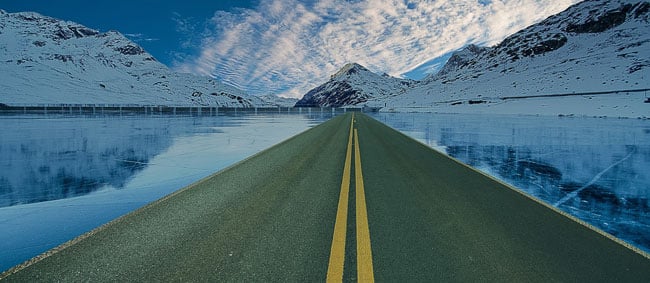
Mar 26, 2019
Anti-ice and deicing systems are important to many industries, especially the global aviation industry. The following excerpt from BCC Research’s report “Global Markets for Ice-Resistant Coatings” offers a short background on ice prevention systems.
Two systems that are widely utilized across the world for snow and ice control strategies are anti-icing and deicing systems. These systems make use of chemical freezing-point depressants to achieve the objective. Ice resistant coatings have the ability to shed ice in a passive system that reduces the requirements for other active anti-icing systems such as bladders or electro-thermal technologies.
Anti-icing Systems
Ice formation on a surface can cause problems across a multitude of areas, such as in transport (aircrafts, cars) and energy supply (high-voltage power lines, air conditioning). Even though various mechanical and electrical anti-icing systems exist, the most favorable solution for this problem is the design of passive polymeric or polymeric or hybrid ice-resistant coatings. These coatings have the ability to shed ice in a passive system that reduces the requirements for other active anti-icing systems such as bladders or electro-thermal technologies.
Ice resistant or anti-ice coatings prevent the formation of bonded snow and ice on the coated surface. Such coatings impart the anti-icing properties to the underling substrate. They can be applied to a wide variety of substrate materials including plastics, metals, glass, concrete, and ceramics, among others. This includes treating the surface or area with anti-icing systems before the freezing weather arrives, with an aim to limit or prevent the buildup of ice. Such surfaces do not require power consumption and are typically based on reducing the strength of ice adhesion or inhibiting the growth of ice.
All anti-ice fluids offer surface protection from ice for a certain period known as the Holdover Time (HOT). HOT for anti-ice fluid depends on the type of containment and prevailing weather conditions.
Deicing Systems
Deicing fluids are utilized to remove the frozen contaminants, such as snow, ice or frost buildup on the surface. Deicing can be achieved by various techniques, such as by mechanical methods (scraping, pushing); heat application; by using dry or liquid chemicals (salts or brines, alcohols, glycols) to lower the freezing point of water; or by a combination of these techniques.
Deicing agents can be classified as solid deicers and liquid deicers. Solid deicers are generally applied after the ice and snow have fallen and bonded to the surface. In comparison, liquid deicers are generally used as anti-icers. Once the snow or ice-bond is broken through deicing, mechanical methods are applied to remove the ice. Thereby, preventing re-freezing or re-bonding, since the deicer becomes diluted due to the melting of ice or snow. Factors that define the effectiveness of deicers include surface temperature, application rate, the amount of moisture or water present, and the applied concentration. However, these chemicals are considered to be toxic in nature. In addition, these products require repeated use and thus, increase the maintenance costs to the operators, as well as cause pollution to the environment.
Types of Deicing and Anti-icing Fluids
Deicing and anti-icing fluids are comprised of four standard types: Type I, II, III, and IV. Deicing fluids are typically ethylene glycol, diethylene glycol or propylene glycol-based fluids, with little concentration of additives such as water, corrosion inhibitors, wetting agents and dye. Anti-icing fluids are based on similar compositions, with an addition of polymeric thickeners. Type I fluids are the thinnest among all types, such that they tend to have the shortest Holdover Times (HOT) or estimated times of protection in active frost or freezing precipitation. In comparison, thickening agents are added to Type II and IV fluids to increase viscosity, leading to longer HOT. Type III fluids are relatively new and contain thickening agents that offer longer HOTs than Type I fluids.
Type I fluids are utilized for deicing and anti-icing objectives but tend to offer limited anti-icing protection. Their application is by heat or in dilute form. However, the application of Type II and IV fluids is by heat or cold and diluted or undiluted state. In North America, Type II and IV fluids are typically utilized for anti-icing objectives and are applied cold. Whereas, in the U.K., these fluids are typically used for both deicing and anti-icing objectives and are applied by heat.
For more information, download the report overview to read the first chapter for free.

Biophotonics: Technologies and Global Markets (PHO024B)

Global Trade: A Strategic Shift The global trade environment is undergoing a dra...

The global demand for cutting-edge materials continues to rise, and at the foref...

We are your trusted research partner, providing actionable insights and custom consulting across life sciences, advanced materials, and technology. Allow BCC Research to nurture your smartest business decisions today, tomorrow, and beyond.
Contact UsBCC Research provides objective, unbiased measurement and assessment of market opportunities with detailed market research reports. Our experienced industry analysts assess growth opportunities, market sizing, technologies, applications, supply chains and companies with the singular goal of helping you make informed business decisions, free of noise and hype.